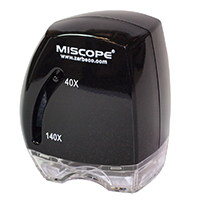When undertaking a forensic document examination, a document examiner will use a variety of technical instruments to perform these examinations and obtain the most useful results. All examinations undertaken by DiD are non-destructive and as such, will not harm your document in anyway.
Microscope
The use of a microscope allows for the determination of such things as stroke direction and line quality. The camera attachment also allows for images to be captured that can be incorporated into certificates and charts.
MiScope®

 This is a portable digital microscope. It combines a digital movie camera, precision optics and LED lighting into a small microscope. The MiScope® takes digital images and has a magnification range from x40-140. The MiScope can be used for both in-house and off-site examinations.
This is a portable digital microscope. It combines a digital movie camera, precision optics and LED lighting into a small microscope. The MiScope® takes digital images and has a magnification range from x40-140. The MiScope can be used for both in-house and off-site examinations.
Video Spectral Comparator (VSC6000)

The VSC6000 is an instrument allowing a document to be examined in the visible,
ultraviolet (UV) and infrared (IR) wavelength ranges. The alternative light sources contained within the VSC can be used to differentiate inks to show such things as the use of different pens or alterations. It can also reveal obliterated or faded entries. The transmitted light feature can be used to show watermarks and can be useful in revealing entries concealed by products like ‘Liquid Paper’ or ‘White-out’.
The VSC can be used to examine the features in identity documents to determine if the document provided is genuine. The instrument has a built-in camera and the images taken can be incorporated into reports or charts.
Electrostatic Detection Apparatus (ESDA)

The ESDA is used to reveal latent impressions (or indentations) in paper.
Indentations are made when a page that is sitting on top of the page of interest is written on. Often indentations can be detected up to several pages deep in a notepad or book, and those indentations may remain detectable for years depending upon storage conditions.
The ESDA is non-destructive and the impressions obtained are permanently preserved on an acetate sheet. This can be scanned and copied so that the results can be incorporated into a report or chart. The ESDA result can be submitted as evidence.
The ESDA can be also useful in detecting page substitutions and alterations made to a document. It is often possible to sequence pen strokes thereby showing backdated entries or added signatures, for example.
Measuring devices and software
Rulers, measuring grids and specialised software such as Adobe Photoshop and Pikaso Write-On
Expert Testimony
When required, our examiners can provide expert oral testimony at court. Findings can be demonstrated by printed charts or electronically.